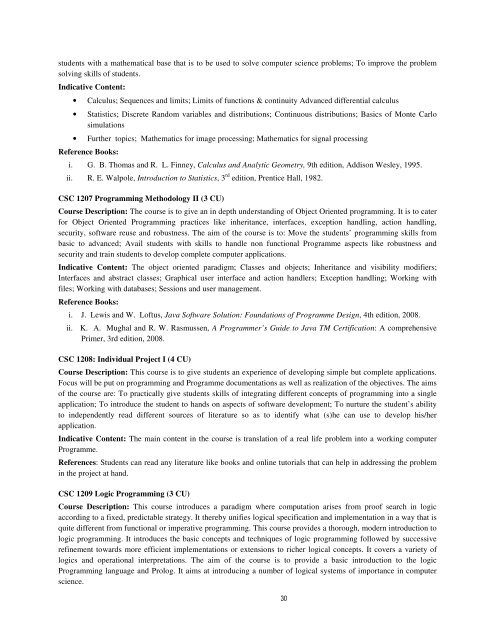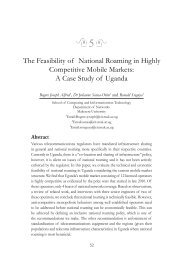Undergraduate Handbook - School of Computing and Informatics ...
Undergraduate Handbook - School of Computing and Informatics ...
Undergraduate Handbook - School of Computing and Informatics ...
You also want an ePaper? Increase the reach of your titles
YUMPU automatically turns print PDFs into web optimized ePapers that Google loves.
students with a mathematical base that is to be used to solve computer science problems; To improve the problem<br />
solving skills <strong>of</strong> students.<br />
Indicative Content:<br />
• Calculus; Sequences <strong>and</strong> limits; Limits <strong>of</strong> functions & continuity Advanced differential calculus<br />
• Statistics; Discrete R<strong>and</strong>om variables <strong>and</strong> distributions; Continuous distributions; Basics <strong>of</strong> Monte Carlo<br />
simulations<br />
• Further topics; Mathematics for image processing; Mathematics for signal processing<br />
Reference Books:<br />
i. G. B. Thomas <strong>and</strong> R. L. Finney, Calculus <strong>and</strong> Analytic Geometry, 9th edition, Addison Wesley, 1995.<br />
ii. R. E. Walpole, Introduction to Statistics, 3 rd edition, Prentice Hall, 1982.<br />
CSC 1207 Programming Methodology II (3 CU)<br />
Course Description: The course is to give an in depth underst<strong>and</strong>ing <strong>of</strong> Object Oriented programming. It is to cater<br />
for Object Oriented Programming practices like inheritance, interfaces, exception h<strong>and</strong>ling, action h<strong>and</strong>ling,<br />
security, s<strong>of</strong>tware reuse <strong>and</strong> robustness. The aim <strong>of</strong> the course is to: Move the students’ programming skills from<br />
basic to advanced; Avail students with skills to h<strong>and</strong>le non functional Programme aspects like robustness <strong>and</strong><br />
security <strong>and</strong> train students to develop complete computer applications.<br />
Indicative Content: The object oriented paradigm; Classes <strong>and</strong> objects; Inheritance <strong>and</strong> visibility modifiers;<br />
Interfaces <strong>and</strong> abstract classes; Graphical user interface <strong>and</strong> action h<strong>and</strong>lers; Exception h<strong>and</strong>ling; Working with<br />
files; Working with databases; Sessions <strong>and</strong> user management.<br />
Reference Books:<br />
i. J. Lewis <strong>and</strong> W. L<strong>of</strong>tus, Java S<strong>of</strong>tware Solution: Foundations <strong>of</strong> Programme Design, 4th edition, 2008.<br />
ii. K. A. Mughal <strong>and</strong> R. W. Rasmussen, A Programmer’s Guide to Java TM Certification: A comprehensive<br />
Primer, 3rd edition, 2008.<br />
CSC 1208: Individual Project I (4 CU)<br />
Course Description: This course is to give students an experience <strong>of</strong> developing simple but complete applications.<br />
Focus will be put on programming <strong>and</strong> Programme documentations as well as realization <strong>of</strong> the objectives. The aims<br />
<strong>of</strong> the course are: To practically give students skills <strong>of</strong> integrating different concepts <strong>of</strong> programming into a single<br />
application; To introduce the student to h<strong>and</strong>s on aspects <strong>of</strong> s<strong>of</strong>tware development; To nurture the student’s ability<br />
to independently read different sources <strong>of</strong> literature so as to identify what (s)he can use to develop his/her<br />
application.<br />
Indicative Content: The main content in the course is translation <strong>of</strong> a real life problem into a working computer<br />
Programme.<br />
References: Students can read any literature like books <strong>and</strong> online tutorials that can help in addressing the problem<br />
in the project at h<strong>and</strong>.<br />
CSC 1209 Logic Programming (3 CU)<br />
Course Description: This course introduces a paradigm where computation arises from pro<strong>of</strong> search in logic<br />
according to a fixed, predictable strategy. It thereby unifies logical specification <strong>and</strong> implementation in a way that is<br />
quite different from functional or imperative programming. This course provides a thorough, modern introduction to<br />
logic programming. It introduces the basic concepts <strong>and</strong> techniques <strong>of</strong> logic programming followed by successive<br />
refinement towards more efficient implementations or extensions to richer logical concepts. It covers a variety <strong>of</strong><br />
logics <strong>and</strong> operational interpretations. The aim <strong>of</strong> the course is to provide a basic introduction to the logic<br />
Programming language <strong>and</strong> Prolog. It aims at introducing a number <strong>of</strong> logical systems <strong>of</strong> importance in computer<br />
science.<br />
30

















